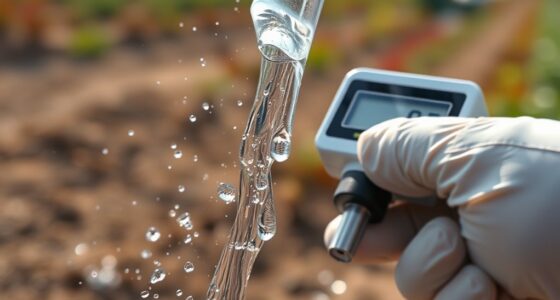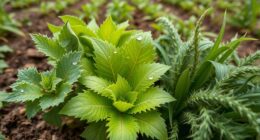Building a greenhouse on a budget is easier than you think. Start by sourcing affordable materials like old windows and PVC pipes. Design a simple structure, like a dome or peaked roof, for stability. Use a step-by-step approach to frame your greenhouse, ensuring proper insulation and ventilation. Regular maintenance keeps it functional and extends its life. There's a lot more to explore about maximizing growth and ensuring long-term success, so keep going to uncover more tips!
Key Takeaways
- Source affordable materials like old windows, PVC pipes, and reclaimed lumber from garage sales or online marketplaces to keep costs low.
- Choose a simple, efficient design such as a dome or lean-to for structural stability and optimal light exposure.
- Frame raised garden beds with repurposed wood and ensure proper ventilation with strategically placed windows and doors.
- Insulate with bubble wrap or horticultural fleece and regularly monitor humidity to maintain a healthy growing environment.
- Implement seasonal adjustments and use vertical gardening techniques to maximize space and growth potential.
Selecting Affordable Materials

When you're building a greenhouse on a budget, selecting affordable materials can make a significant difference in your overall costs.
Start by searching for old windows at garage sales or online marketplaces like Craigslist. They not only add character but also serve as excellent walls for your greenhouse.
Searching for old windows at garage sales or online can add charm and function to your budget-friendly greenhouse.
For the frame, consider using PVC pipes; they're lightweight, affordable, and easy to work with. Cover your structure with greenhouse plastic, which typically costs around $12.50 and helps maintain a warm environment for your plants.
Don't forget about incorporating scrap lumber from previous projects or local reclaimed materials. By using these options, you can keep your total construction cost under $100 while still creating a functional greenhouse.
Designing Your Greenhouse

When designing your greenhouse, think about a shape that maximizes space and stability, like a dome or lean-to.
You can save money by incorporating repurposed materials, such as old windows and doors, which also help with natural light and ventilation.
Don't forget to plan for structural integrity and a layout that makes gardening tasks easy and efficient. Additionally, consider using self-watering planters to simplify your watering routine and enhance plant growth.
Choosing a Suitable Design
Choosing the right design for your greenhouse is essential to maximizing both functionality and cost-effectiveness. A dome shape offers structural stability and excellent light absorption, making it a smart choice.
If space is tight, consider a lean-to design, which uses existing walls or fences to cut down on materials and costs. Mixing glass and plastic sheeting enhances ventilation and insulation, helping you maintain the ideal temperature and humidity for your plants.
Additionally, think creatively by using old windows for walls and scrap lumber for framing. This approach not only keeps costs under $100 but also adds unique charm.
Don't forget to include functional features like doors and windows for easy access and effective temperature control in your greenhouse.
Utilizing Repurposed Materials
Utilizing repurposed materials can greatly cut costs while adding character to your greenhouse design. You can collect old windows and lumber from garage sales or online marketplaces, framing the walls with repurposed 2x4s for sturdiness. A greenhouse from PVC pipes offers a lightweight, flexible option for a dome shape. Cover odd areas with greenhouse plastic sheeting to enhance insulation and light penetration without breaking the bank. Mixing various reclaimed materials, like glass and plastic, can elevate both functionality and aesthetics. Additionally, incorporating natural elements into your design, such as vintage items or woven baskets, can enhance the overall aesthetic and create a charming atmosphere.
| Material Type | Source | Use in Greenhouse |
|---|---|---|
| Old Windows | Garage Sales/Online | Wall Panels |
| Spare Lumber | Personal Storage | Framing |
| PVC Pipes | Hardware Store/Online | Structure |
| Greenhouse Plastic | Gardening Supply Stores | Covering Gaps |
Ensuring Structural Stability
Repurposed materials not only save you money but also set the stage for a sturdy greenhouse. Use durable materials like repurposed wood and PVC pipes to craft a strong structure that can handle environmental stresses, such as wind and snow.
For added stability, cement posts into the ground to anchor your greenhouse, preventing any movement during storms. Consider designing a dome shape or peaked roof to enhance structural integrity, promoting effective runoff of snow and rain.
Incorporate horizontal support beams to evenly distribute weight, especially in larger greenhouses. Finally, regularly inspect the greenhouse's structural components, like screws and joints, to maintain stability and reinforce its structure over time.
Step-by-Step Construction Guide

Now that you've designed your greenhouse, it's time to gather your materials and start building.
You'll want to focus on sourcing affordable options while keeping the construction steps simple and straightforward.
Once the structure is up, we'll discuss how to set up the interior for ideal plant growth.
Materials Selection and Sourcing
As you begin building a greenhouse on a budget, sourcing the right materials is essential to keeping costs low while ensuring durability.
Start by searching for low-cost materials like old windows, reclaimed lumber, and PVC pipes at local garage sales or online marketplaces. Create a cost breakdown to track your expenses; for instance, lumber typically costs around $20, while window glass can be found for about $3.
For covering the greenhouse, consider 4-mil greenhouse plastic sheeting, available for approximately $12.50. Use sturdy 2x4s for framing and secure your assembly with screws.
Don't hesitate to embrace creativity, utilizing scrap materials to build a unique greenhouse that fits your gardening needs and budget. Additionally, consider incorporating organic farming methods to enhance the overall sustainability of your gardening practices.
Construction Steps Overview
Building your greenhouse involves a series of straightforward steps that can turn your vision into reality without breaking the bank. Start by framing two raised garden beds with a two-foot walkway, using repurposed wood to save money.
Next, create a dome structure by attaching PVC pipes, adding horizontal pipes for extra support. Frame the door and windows with 2×3 lumber, and look for recycled windows online to cut costs further.
Once the structure is ready, securely wrap your DIY greenhouse in 4-mil plastic sheeting, using staples and clamps for a snug fit that enhances insulation.
Finally, position your windows and doors strategically to manage ventilation and temperature, ensuring easy access for maintaining your plants.
Interior Setup Tips
To create an efficient and functional interior for your greenhouse, start by maximizing vertical space and organization. Build your own greenhouse shelving inside using cedar crates, installing supports at 36 inches high. This allows for ample storage while keeping your plants accessible.
Next, construct a work table from scrap lumber to provide a dedicated gardening workspace. Consider gutter gardening as well; planting round Parisian carrots in gutters saves space and makes harvesting easy.
Verify proper ventilation by allowing windows to open, promoting air circulation and temperature control. Finally, address pest issues by enclosing your greenhouse, offering protection for your plants while maintaining a suitable environment for growth.
These tips will enhance your greenhouse experience greatly.
Insulation and Ventilation Techniques

When it comes to creating a thriving greenhouse environment, effective insulation and ventilation are key factors you can't ignore. Secure plastic sheeting tightly with staples and clamps, and consider using hose pieces for added stability against wind and temperature fluctuations.
Incorporate windows and doors into your design for better temperature control; closing them helps maintain warmth during colder months. For ventilation, open windows or doors on opposite sides to create airflow, preventing humidity build-up and mold growth.
You can also use bubble wrap or horticultural fleece as extra insulation to retain heat in winter, protecting fragile plants. Regularly monitor humidity and temperature levels with a thermometer, adjusting ventilation as needed to guarantee a healthy growing environment. Additionally, understanding refrigeration cycle can help you implement more effective temperature control strategies in your greenhouse.
Maximizing Growth With Your Greenhouse

Maximizing growth in your greenhouse starts with smart design choices and efficient use of space. Here are some strategies to boost your garden's productivity throughout the growing season:
- Use a dome-shaped design for better light absorption and structural integrity.
- Incorporate recycled windows or doors to create insulation, promoting year-round growth of vegetables like tomatoes and corn.
- Implement a shelving system with repurposed crates to optimize vertical space, accommodating various plants without overcrowding.
Don't forget to plant root vegetables in gutters for easy harvesting and space-saving.
Regularly monitor temperature and humidity levels, adjusting ventilation by opening your windows or doors as needed.
These simple adjustments can make a significant difference in your greenhouse success!
Maintenance Tips for Longevity

Maintaining your greenhouse is essential for guaranteeing its longevity and the health of your plants. Regularly inspect and repair any damaged plastic sheeting or window frames to maintain insulation and prevent leaks. This is especially important during heavy weather.
Use maintenance tips like cleaning surfaces and windows to maximize sunlight exposure and reduce pests. Monitor humidity and temperature levels with a thermometer and hygrometer, adjusting ventilation or shading as needed. Applying a layer of mulch inside helps retain moisture and regulate temperature.
Finally, verify proper drainage by clearing debris from gutters and downspouts. If you need to make repairs, use pre-drilled holes for easier assembly and longevity. With these steps, you'll keep your greenhouse thriving for years to come.
Frequently Asked Questions
What's the Cheapest Way to Build a Greenhouse?
The cheapest way to build a greenhouse is by using repurposed materials like old windows or spare lumber. You can find affordable supplies at garage sales or online marketplaces.
Consider a lean-to structure against a wall to save on framing. Use inexpensive greenhouse plastic sheeting for the cover instead of glass.
Focus on a simple design that prioritizes ventilation and stability, which will help you keep costs low while still protecting your plants.
Is It Cheaper to Build or Buy a Greenhouse?
Imagine nurturing your own garden oasis, but you're torn between building or buying a greenhouse.
It often boils down to your skills and resources. If you've got DIY skills and reclaimed materials, constructing one can be cheaper, sometimes around $100.
However, purchasing a pre-made greenhouse might save you the hassle, typically starting at $130.
Weigh your options carefully; the right choice can grow your garden dreams without breaking the bank.
How Do I Keep My Greenhouse Warm in the Winter?
To keep your greenhouse warm in the winter, start by insulating it with bubble wrap or horticultural fleece to minimize heat loss.
Install a thermometer to monitor the temperature and adjust ventilation as needed.
Use thermal mass, like water barrels, to retain heat during the day.
Seal gaps around windows and doors to prevent drafts.
If necessary, add a small electric heater or heat lamps for extra warmth during those chilly spells.
What Is a Cheaper Alternative to a Greenhouse?
If you're looking for a cheaper alternative to a greenhouse, consider using a cold frame.
It's simple to build with old windows or wood, providing frost protection for your plants.
Tunnels made from PVC pipes and plastic sheeting can create a microclimate for season extension.
You could also try raised beds with clear plastic covers or cloches to shield individual plants.
An indoor garden setup with shelving and grow lights is another great option!
Conclusion
Building a greenhouse on a budget is like planting a seed; with patience and care, it can flourish into something beautiful. By selecting affordable materials and following our construction guide, you'll create a thriving space for your plants without breaking the bank. Remember, proper insulation and ventilation are key to their growth, while regular maintenance will keep your greenhouse vibrant for years to come. Embrace your green thumb, and watch your garden dreams come to life!










